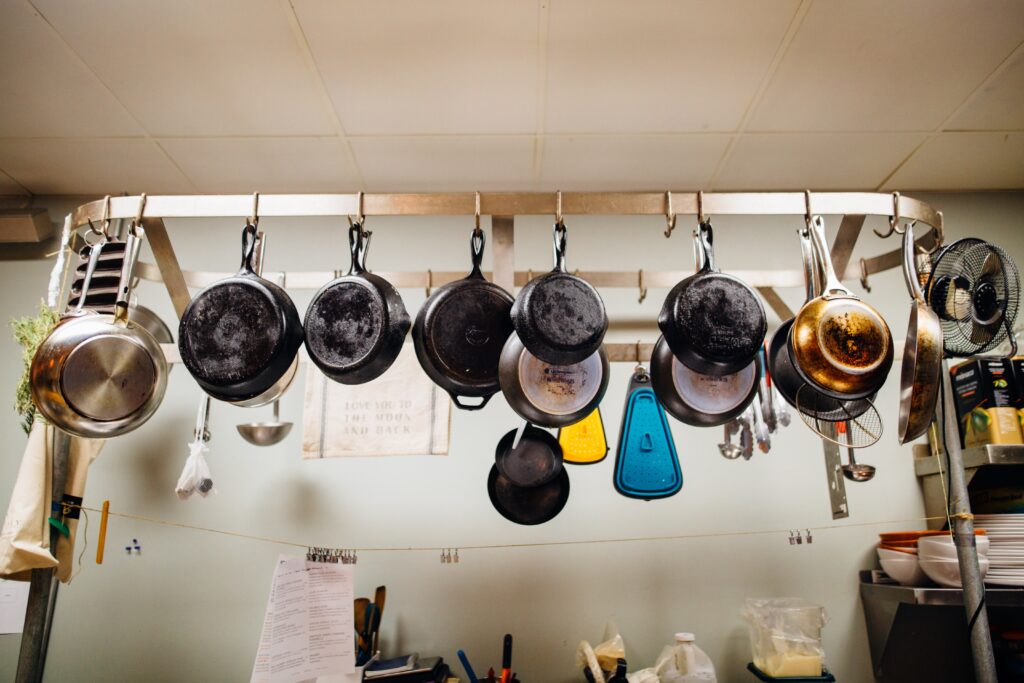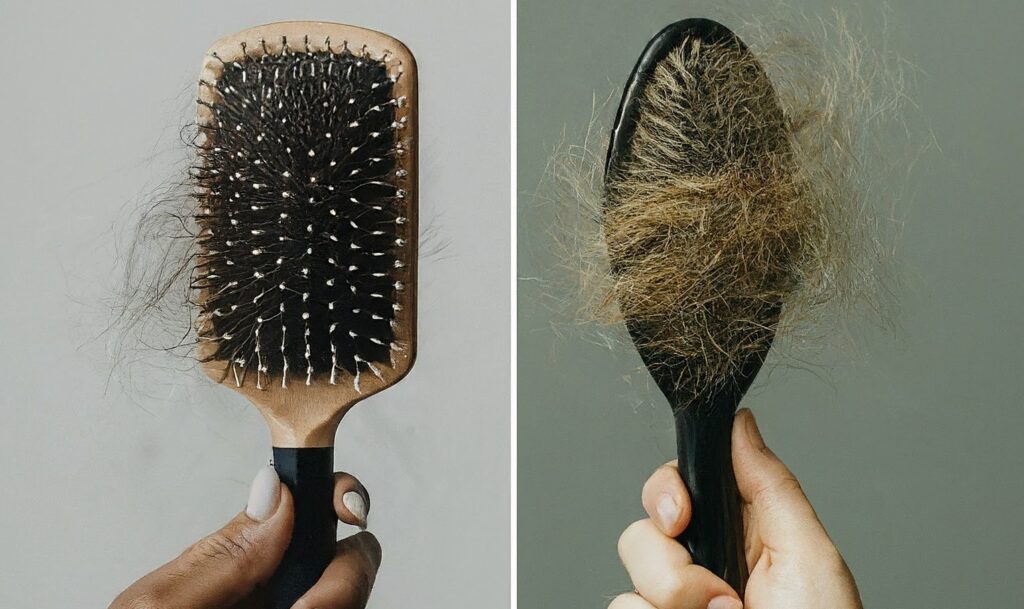Table of Contents
In the bustling heart of every home, the kitchen, the choice of cookware can make a world of difference not only to your culinary adventures but also to your health. With a multitude of options available, it can be challenging to select the perfect cookware that combines cooking convenience with safety. In this comprehensive guide, we will delve into five popular types of cookware: Non-Stick, Stainless Steel, Cast Iron, Anodized, and Ceramic. We’ll explore their pros and cons, their impact on health, proper usage, and ultimately recommend the best choices, all while keeping your focus keyword, “Healthy Cookware,” in mind.
Non-Stick Cookware: Cooking Made Easy but not a healthy Cookware choice
Composition: Non-stick cookware typically consists of a metal base, often aluminum, covered with a non-stick coating. This coating is typically made from a synthetic material known as PTFE (polytetrafluoroethylene).
Pros: Non-stick cookware is renowned for its convenience. Food effortlessly glides off the smooth surface, reducing the need for excess oil and making cleanup a breeze. It’s budget-friendly and lightweight, making it accessible and user-friendly for many.
Cons: However, convenience comes at a cost. The non-stick coating can wear out over time, necessitating replacement. Overheating can lead to the release of toxic fumes, posing potential health risks. Plus, the coating is susceptible to scratching, diminishing its non-stick properties.
Health Impact: Improper use of non-stick cookware, such as overheating or using metal utensils that damage the coating, can lead to the ingestion of harmful particles. Long-term exposure to perfluorooctanoic acid (PFOA), a chemical used in older non-stick coatings, has been associated with health issues like thyroid problems, high cholesterol, and even cancer.
Proper Usage: Use non-stick cookware at recommended temperatures and avoid overheating. Ensure proper ventilation in your kitchen to dissipate potential fumes. If you notice any damage or deterioration of the non-stick coating, it’s advisable to replace the cookware. Choose cookware from reputable brands that use high-quality non-stick coatings and label their products as PFOA-free.
Stainless Steel Cookware: Durability Meets Safety
Composition: Stainless steel cookware is made entirely of stainless steel, a corrosion-resistant alloy composed primarily of iron, with varying amounts of chromium and nickel.
Pros: Stainless steel cookware is renowned for its durability, resistance to scratches and dents, and safety even at high temperatures. It’s incredibly versatile, suitable for various cooking methods, from searing to deglazing.
Cons: On the flip side, stainless steel pans may require more oil or butter to prevent sticking, and they often come with a higher price tag compared to non-stick options.
Health Impact: Stainless steel is generally considered safe for cooking and is considered one of the best healthy cookware choices. However, some individuals may be sensitive to nickel, a component of stainless steel, so it’s essential to be aware of any allergies.
How to Choose the Right Utensil: Always buy food-grade stainless steel cookware with proper certification. Look for cookware labeled as 18/10 stainless steel, indicating the presence of 18% chromium and 10% nickel, ensuring corrosion resistance and safety.
Proper Usage: To make the most of stainless steel, use it within its versatile range of cooking methods. Be prepared to use a bit more oil or fat to prevent sticking. Keep in mind that while stainless steel is safe for most, those with nickel allergies should opt for cookware with a higher nickel content.
Cast Iron Cookware: Time-Tested healthy cookware and Nutrient Boosting
Composition: Cast iron cookware is made entirely of cast iron, a heavy, durable metal alloy primarily composed of iron, with small amounts of carbon.
Pros: Cast iron cookware boasts exceptional longevity, capable of lasting for generations. Its ability to distribute heat evenly makes it ideal for slow cooking and baking. Additionally, it can infuse your food with small amounts of iron, offering potential health benefits for those with iron deficiencies.
Cons: The weight of cast iron cookware can be a drawback, making it challenging to maneuver. It also requires seasoning and careful cleaning to prevent rust.
How to Choose the Right Utensil: When choosing cast iron cookware, opt for pieces pre-seasoned or look for instructions on seasoning before use. Check for a smooth cooking surface, which indicates proper manufacturing and finishing.
Health Impact: Cast iron’s potential to add iron to your food can be beneficial for your health and is considered one of the best healthy cookware choices, but it may not suit everyone. Some may find the increased iron intake problematic.
Proper Usage: Proper care of cast iron cookware is crucial. Season it regularly to maintain its non-stick properties and prevent rust. Be prepared for its weight and maintain its cleanliness.
Anodized Cookware: The Durable and Enhanced Non-Stick Option
Composition: Anodized cookware features a metal base, typically aluminum, that has undergone an electrochemical process to harden the surface, creating an oxide layer that acts as a non-stick coating.
Pros: Anodized cookware offers enhanced durability and non-stick properties, combining the best of both worlds. It’s resistant to scratches and typically safe for high-heat cooking.
Cons: On the downside, anodized cookware can be more expensive than other options.
How to Choose the Right Utensil: Ensure that the anodized cookware you select is from a reputable brand and follows the industry standards for anodization.
Health Impact: Anodized cookware is considered healthy cookware choice, as it doesn’t react with food or release harmful substances when used correctly.
Proper Usage: Anodized cookware is relatively low-maintenance. Use it for various cooking methods without the need for excessive oil or butter.
Ceramic Cookware: Healthy cookware and Versatile
Composition: Ceramic cookware features a metal base (usually aluminum) with a ceramic non-stick coating. This coating is typically made from natural minerals, including clay and sand.
Pros: Ceramic cookware is cherished for its non-reactive surface, ensuring that your meals retain their flavors. It distributes heat evenly, offers natural non-stick properties, and is easy to clean. Plus, it’s versatile and eco-friendly.
Cons: While generally durable, the quality of the ceramic coating can vary. Damage to the coating can affect its non-stick properties.
How to Choose the Right Utensil: Opt for ceramic cookware from reputable brands known for their quality coatings. Look for products that explicitly state their ceramic composition.
Health Impact: Ceramic cookware is generally considered safe and does not leach harmful substances into food when used correctly.
Proper Usage: Use gentle utensils to avoid damaging the ceramic coating. Keep heat within recommended levels to maintain its non-stick properties. Regularly inspect for any signs of wear and tear.
In Conclusion: The Best Choices for Healthy Cookware
When it comes to choosing healthy cookware, both stainless steel and cast iron stand out as top options. They are durable, safe, and versatile. Stainless steel, with its ease of use and safety, takes the lead for most households. Cast iron follows closely, offering added iron benefits but requiring a bit more care.
Anodized cookware is also a solid choice, combining durability and enhanced non-stick properties. Ceramic cookware, while versatile and healthy, requires careful handling and maintenance.
In the end, your choice depends on your cooking preferences, dietary needs, and lifestyle. Prioritize safety, longevity, and your cooking habits when making your selection.
FAQs: Healthy Cookware Queries, Answered
Is non-stick cookware safe if used carefully?
While careful use can minimize risks, the potential release of toxic fumes at high temperatures remains a concern. Stainless steel or cast iron offers safer alternatives for healthy cookware.
Can I cook acidic foods in cast iron or stainless steel pans?
It’s generally safe to cook acidic foods in stainless steel pans. For cast iron, it’s best to avoid prolonged contact with highly acidic ingredients, as it can affect the seasoning.
How do I season a cast iron pan?
To season a cast iron pan, coat it with a thin layer of vegetable oil or shortening and heat it in the oven at 350-400°F (175-200°C) for about an hour. Repeat as needed to maintain the seasoning for healthy cooking.
Are there any health concerns with stainless steel cookware?
Stainless steel is considered safe for cooking. However, some people may be sensitive to nickel, a component of stainless steel. If you have nickel allergies, choose cookware with a higher nickel content for healthier cooking.
Can anodized cookware be used for high-heat cooking?
Yes, anodized cookware is generally safe for high-heat cooking. The anodization process makes it durable and heat-resistant. However, always follow the manufacturer’s recommendations for safe use.
Is ceramic cookware suitable for induction cooktops?
Some ceramic cookware is compatible with induction cooktops, but not all. Check the manufacturer’s specifications to ensure compatibility.
What are the signs that it’s time to replace my cookware?
Signs of wear and tear, such as chipping, warping, or loss of non-stick properties, indicate that it’s time to replace your cookware for healthier cooking.
Can I use metal utensils with ceramic cookware?
It’s best to avoid metal utensils with ceramic cookware, as they can damage the ceramic coating.



